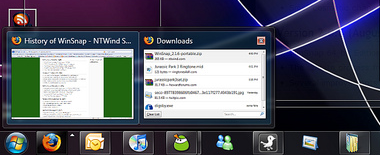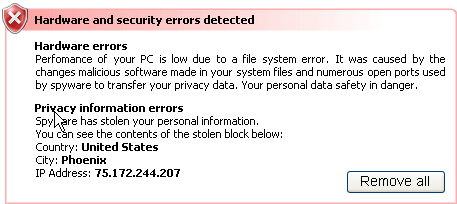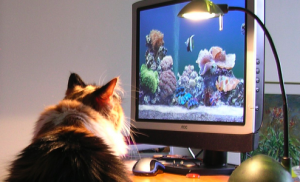I saw this new “iPOOd” trowel at a Virginia REI store. Like an actual iPod, it is lightweight and has very few buttons. Unlike an iPod, it is good for digging.
Down & Up Worm Worst Ever
Over the last few months, the “Down and Up” worm, also known as “Conficker” has infected an estimated 6% of all PCs worldwide. The concern is what the authors will now do with all these compromised systems. They could ask for credit card information as the bogus Antivirus 2009 does. They could use the computers to attack and demand money from websites through denial of service (DOS) attacks. No one knows yet what the intentions of the authors are.
It is considered the most professional and pernicious worm attack that researchers have yet seen. It effects all versions of Windows. As a worm, it does not require any user action for the computer to be compromised. The machine must just not be recently patched.
 Download the Malicious Software Removal Tool (also available in Windows Updates) in order to protect your computer or to possibly get rid of the worm (most people who have it do not know). Then you can feel comfortable that your computer is owned by you and not by the bad guys.
Download the Malicious Software Removal Tool (also available in Windows Updates) in order to protect your computer or to possibly get rid of the worm (most people who have it do not know). Then you can feel comfortable that your computer is owned by you and not by the bad guys.
Windows 7 Beta
Microsoft’s beta of Windows 7 was released a couple of days ago. Prior to that, it had been seen and reviewed extensively because it was on bittorrent (peer-to-peer) sites. There is speculation that Microsoft themselves leaked this build to the Internet to build interest. Given the poor consumer embrace of Windows Vista, it appears that Microsoft is using this update to ditch the term Vista. Windows 7 does appear to be faster and better than Vista.
Back Story
After Vista’s so-so entry into the world, Microsoft revamped their development approach to Windows. A few years ago, Microsoft’s approach was to have a main development build of Windows. When it was time to make the desktop or server versions, they would fork the source code tree. This forked approach proved unwieldy for keeping track of all the code.
For Windows 7, the code is now componentized. This means that each part of the OS is worked on individually and managed in one spot. To make the desktop OS, you simply pull all the components needed together. For Windows Server, you do the same. Due to this streamlined approach, not only will Microsoft be able to come out with OSs in a timely manner, but updates will also be smaller and released more frequently.
Optimizations and Drivers
In the process of modularizing the OS, they also looked through the code to see what was used the most and worked on optimizing that code. So while the entire OS hasn’t been “optimized”, the stuff that matters is. I’m running Windows 7 on my Acer Aspire One, and it runs quite fast, faster than Vista or XP.
Since Microsoft wants Windows 7 to launch without a hitch, they’re not changing the driver model from Vista. So if your printer or scanner now (finally) works, then it’ll work in Windows 7 too. They are also putting pressure on hardware manufacturers to have signed/updated drivers.
What’s new in Windows 7?
The biggest difference you can see in Windows 7 is the new taskbar.

You aren’t forced to use the taskbar and you can go back to the old way if you want. This taskbar looks much like the dock in Apple’s Mac OS X, but it’s a little nicer. You can run a program more than once (can’t do that on a mac). But the best thing is Aero Peek.

I’ve been looking for something equivalent to OS X’s exposé for quite some time, and this is better. When you mouseover the program icon in the task bar, it brings up a thumbnail of every window that application has. When you move over the thumbnail, that window fades in while all other windows fade out. If you have a phone number or some quick info you need to view in another application, you can get to it without any mouse clicks.
Not Far Away
For a beta, Windows 7 is already very stable and is reportedly feature complete. This means that Microsoft can’t be far from releasing it, possibly by mid-2009. With the new Mac OS X Snow Leopard arriving around that time too, it should be a good year for operating system upgrades.
Malicious Software Removal Tool (MSRT)
Microsoft recently reported that their Malicious Software Removal Tool (MSRT), which was included in Windows Updates on December 9, 2008, has now removed over 400,000 copies of the nefarious “Antivirus 2009”.
An Arlington, VA client was recently infected by that Antivirus 2009 malware. It has been the most pernicious malware that I have seen recently, as most users can be tricked into installing it. Many fake sites exist that you might find during a normal web search. The sites appear to be a standard Windows Control Panel page which pretends to search for and find viruses. If you click “Ok” or “Remove All” you will be infected.
It will eventually take away all administrative rights from you and ask for your credit card to update and remove the viruses. Of course, it never removes anything, but instead gives your credit card info to the bad guys to use as they wish. Your computer is also a zombie ready to do whatever they ask of it.

The problem is that the dialog boxes and alerts look just like legitimate ones that might appear from Microsoft. See the fake Antivirus 2009 alert above.
I mentioned another variant of this malware called Antivirus XP 2008 in an earlier post.
While there are other tools you could use, Microsoft’s Malicious Software Removal Tool (MSRT) is a real solution that will remove and protect the computer from this Malware. It is available as a critical update from Microsoft.
It is not always apparent how to run Microsoft’s Malicious Software Removal Tool (MSRT). If you have it installed, you can just go to Start – Run and they type mrt
Common Computer Problems and Fixes
 Lifehacker.com has an article on how to Help Clueless Relatives with Their Computer Problems. These are common problems that come up with most PCs. By following this advice, you can fix your computer or the computer of those who consider you the computer expert in the family.
Lifehacker.com has an article on how to Help Clueless Relatives with Their Computer Problems. These are common problems that come up with most PCs. By following this advice, you can fix your computer or the computer of those who consider you the computer expert in the family.
“It takes forever to start up.”
If your loved one has installed any software on the computer—especially ISP-specific packages that automatically include bundled add-ons—there’s no doubt unnecessary items have planted themselves into its startup. Use our complete guide to speeding up your startup to get rid of the stuff they don’t need, and save CPU cycles and time on boot-up.
“I keep getting a pop-up saying I need to pay for my antivirus software.”
If the default trialware antivirus software that came pre-installed is now bugging your clueless relative to pay for a subscription, uninstall it. Then, check out Lifehacker readers’ five favorite—and FREE—AV packages ready for download and installation. To fast-track to a free replacement, grab the free edition of AVG.
“When I get on the internet things look weird” or “I keep getting these annoying popup ads.”
Thoroughly check your relative’s PC for evidence of malware: like a hijacked web browser that redirects google.com to an Asian porn site, unsolicited pop-up ads, or suspicious programs named things like “Keypress Watcher.” If you suspect nefarious software has glommed onto Windows, get to scrubbing. Back in 2006, we ran down how to fix Mom and Dad’s malware-laden computer and the advice still stands. Go straight for a copy of Ad-Aware Free and Spybot Search & Destroy to get started.
Then, download and install Firefox, set it as the default browser, and replace all the IE shortcuts labeled “Internet” with the fox.
“I can’t find the digital photos I downloaded last month.”
If Aunt Bertha never gets the photos and videos she took with her digicam onto her computer—or she does, but they get lost in the abyss of her hard drive—make sure she has the right software to preview and find ’em. Install Picasa 3 and scan your loved one’s entire hard drive for digital photos to add them to the library.
Relatives who take digital home videos should also get a free copy of VLC installed to insure that they’ll be able to play any clip they’ve got.
“I’m running out of hard drive space.”If Uncle Marty thinks he needs a new computer because he keeps getting a “low disk space” message, tell him all is not lost. Find out where all that gigabytage is going by visualizing his hard drive usage with free tools that will map what files are taking up what space. Then, declutter his hard drive of the bits and bytes he doesn’t need (and didn’t know he had).
“The internet stopped working.”
The worst family tech support situation to get in is one that involves no (or a very slow) internet connection. Before you head over to Cousin Bob’s house, load up a USB drive with the software you’ll need to troubleshoot things without a connection (or without a broadband connection). TechRadar compiles a list of fix-it tools you can take with you to the family holiday get-together.
Macs Solve These Problems
This list is for PCs only. Macs typically do not have any of these problems, so you might suggest that your relatives buy a Mac if they can afford it and they are regularly having trouble.
Remote Access
Another idea is to install LogMeIn (PC and Mac) on their computer and add their computer to your list so that you can fix problems when you aren’t there. iChat (on Mac) and VNC also work well to remotely control a computer and fix problems.
Speed Up and Slim Down Windows
Other advice for improving computer performance is in our articles on speeding up Windows XP and Windows Vista.

